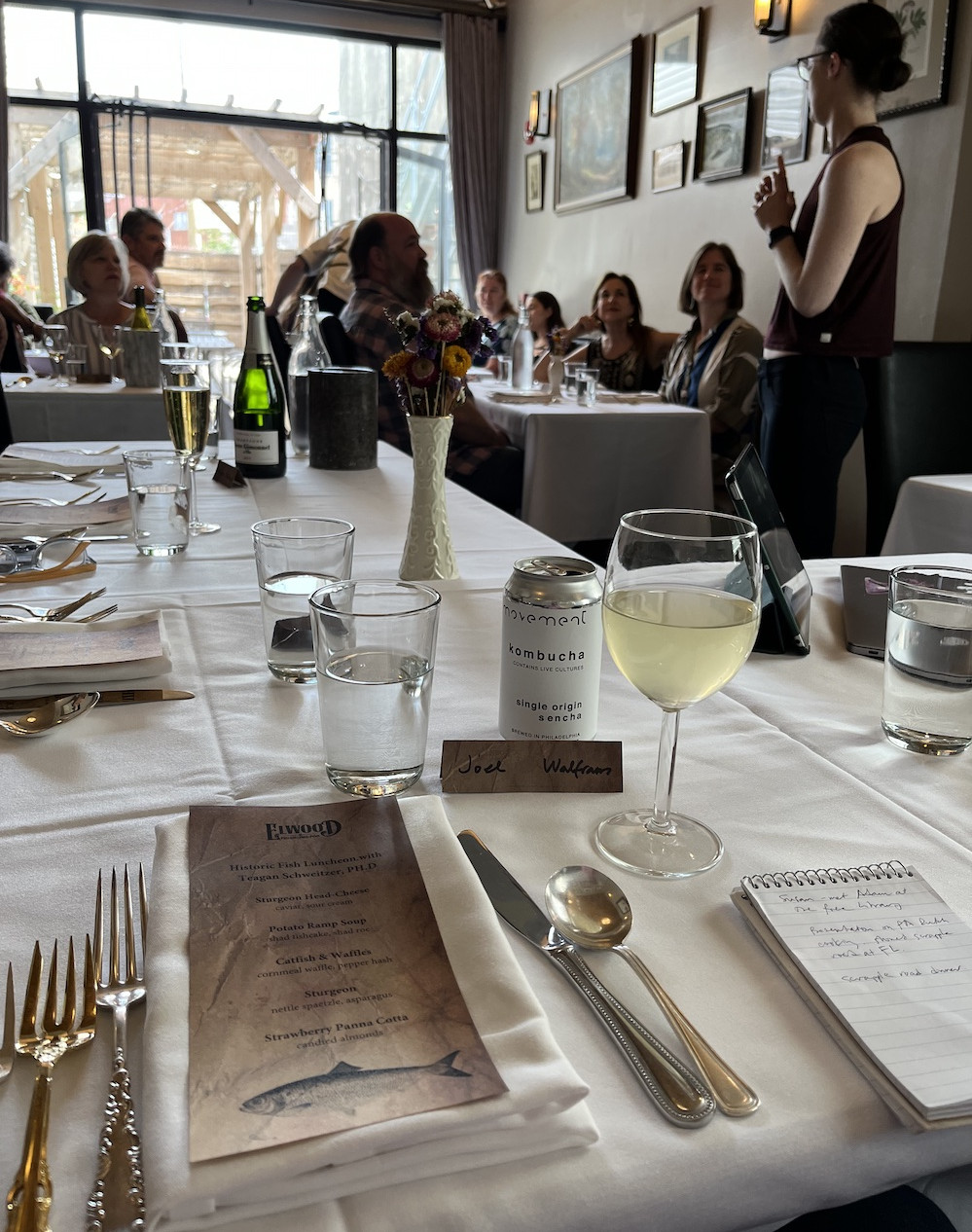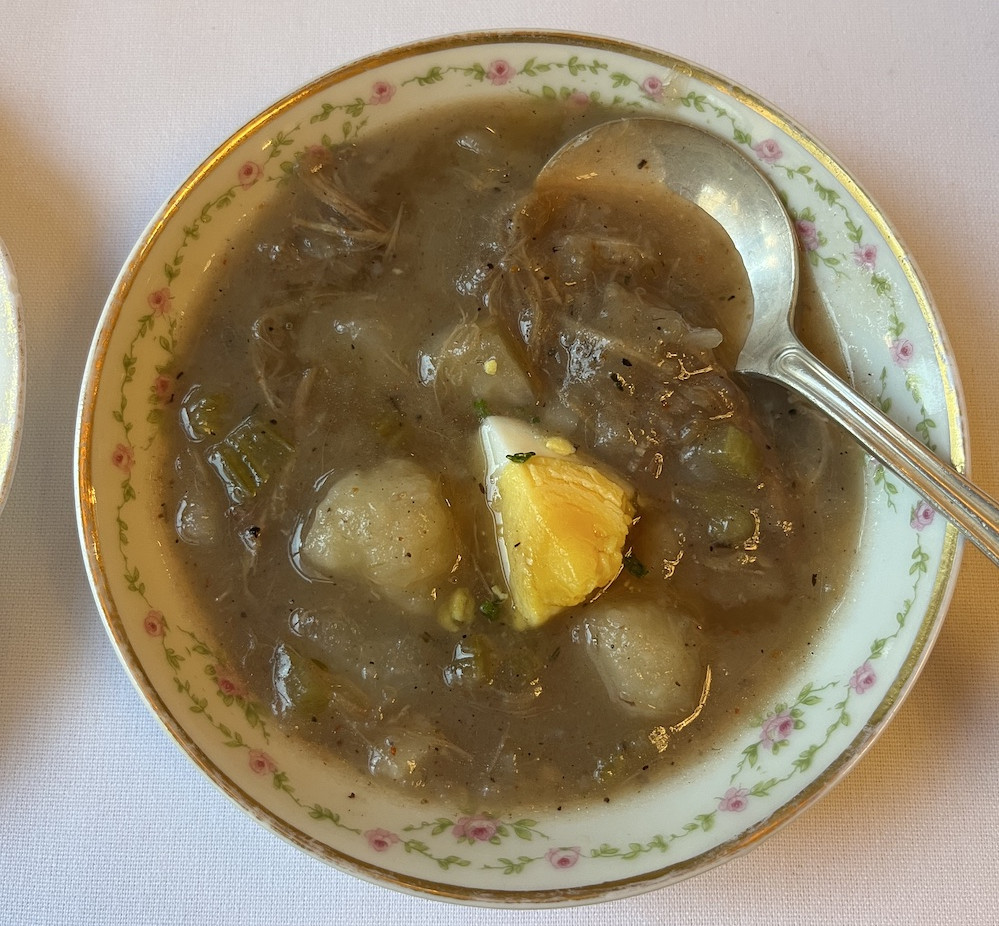Reviving the “Unsexy” Food of Pennsylvania’s Past
Many of the hottest restaurants in Philly are innovating global cuisines and blurring cultural boundaries. In 2023, can Elwood win over diners with shad and snapping turtle?

Archeologist and local food historian Teagan Schweitzer addresses the crowd at Elwood’s historical fish luncheon. / Photography by Joel Wolfram
An archeologist recites a paean to shad before a couple dozen people who fill Elwood’s rowhouse dining room one Sunday afternoon in May.
“Tender as the heart of a maiden, delicate in flavor as the scent of a dry rose, a very sonnet in the form of a fish.”
She goes on to read more ecstatic testimonials from Philadelphians who lived over a century ago as chef Adam Diltz carries a tray of ceramic bowls that thicken the air with the scent of the sea. When my bowl arrives, the server, Jose Gonzalez, pours a green moat of potato-ramp soup around the shad fishcake, which is garnished with orange flower petals and saline slices of shad roe. “Are you getting hungry yet?” jokes the archeologist, Teagan Schweitzer.
Elwood swapped its usual afternoon tea service for the day to host a “Historical Fish Luncheon,” a special five-course menu featuring fish that were long-ago staples of Philadelphia cuisine. Between courses, Schweitzer, who wrote her dissertation on Philadelphia food history, talks about her work analyzing the bones of these fish and other animals dug up during construction on I-95, and shares anecdotes that recall a time when the Delaware and Schuylkill rivers were teeming with shad, sturgeon and catfish.

Shad fishcakes
The American shad migrates from the ocean every spring to spawn in coastal rivers. It was once a highly anticipated seasonal delicacy in Philadelphia, despite the fact that the fish was riddled with bones.
“They would actually say ‘the season of thumping people on the back has almost arrived’ when they were talking about eating shad,” Schweitzer tells us lunch-goers at Elwood as we prepare to dig into Diltz’s fishcakes. Fortunately, he’s spared us this historical peril — the fishcakes are meltingly tender and bone-free, and the herby potato-ramp soup washes them down with a wasabi-like kick.
Themed historical menus are one way Elwood is trying to reacquaint Philadelphians with the area’s culinary heritage. Since Diltz opened the restaurant four years ago on an out-of-the-way stretch of Frankford Avenue in Fishtown, his focus on history and place has set Elwood apart in Philadelphia’s food scene. While many of the hottest new restaurants in town are innovating global cuisines and blurring cultural boundaries, Diltz remains committed to Pennsylvania cooking that draws inspiration from the past.
“It’s the exact opposite of cool,” Diltz says. “Pennsylvania Dutch has always had the ‘unsexy’ label to it.”
But Elwood holds plenty of appeal for people eager to experience the region’s culinary heritage and who aren’t deterred by proteins like goose or snapping turtle. The history the BYOB is unearthing opens up new possibilities for our local food culture. Still, it’s not an easy path in 2023.

Elwood’s chef, Adam Diltz
Turtle and Rabbit
Elwood’s 26-seat dining room is quiet the next time I dine there, at 7 p.m. on a Friday. A few parties are seated in a formal but cozy space appointed with dark leather chairs, white tablecloths and vintage paintings of the Pennsylvania countryside. Bob Dylan and Leonard Cohen play softly through the Sonos. Diltz floats between the kitchen and dining room, occasionally stopping to banter with guests.
A glance at the menu reveals Elwood’s total indifference to the existence of vegans and vegetarians – one of the first signals of its old-fashioned sensibility. There’s not a single plant-based dish among the family-style main courses, which feature portions of meat and fish that are meant for two but could easily feed four. The Kensington snapper soup appetizer drives home the historic bent. It’s the kind of dish my curiosity alone compels me to order.

Kensington snapper soup
Turtle soup is a disappearing Philadelphia dish that was once ubiquitous. Elwood’s version is based on a hundred-year-old Philadelphia recipe. Gonzalez, the server, brings over a tureen with a silver ladle and sets down a bottle of hot-pepper-infused sherry – “the sriracha of the 19th century,” he calls it. The snapping turtle meat tastes like exceptionally tender pulled chicken, and the sherry ties each spoonful together with a nutty punch. I may have ordered it for the novelty factor, but it turns out to be one of the most interesting dishes I’ve had this year.
Diltz’s interest in local food history grew out of his upbringing in rural Northeast Pennsylvania. His Pennsylvania Dutch family took sustenance from the land – from the game he hunted with his grandfather Elwood, the restaurant’s namesake, to the turnips they grew to stockpile for the winter. In high school, Diltz discovered the writing of James Beard and chefs like Paul Prudhomme who were reviving regional American food. When he went to culinary school, Diltz saw parallels between the game meats he was raised on and the recipes of classical French cooking. He worked in an old-school French restaurant in Chicago in the 2000s and had a stint at a farm-to-table restaurant in Tennessee before finally returning to Pennsylvania with a dream to open his own regional American restaurant.
“I knew this is what I wanted when I was, you know, in Chicago with fuckin’ cockroaches and rain dripping down the ceiling and fuckin’ eating crackers, you know? This was the dream,” Diltz says.
For my entrée at Elwood that night, I order the “Whole Gobbler’s Ridge Farm Rabbit.” In a touch of showmanship, Diltz presents the roasted rabbit to the table before bringing it back for carving and serving on a platter with roasted seasonal vegetables. It comes with a bowl of mashed potatoes and a flotilla of condiments, including sauerkraut, pepper hash, apple butter and housemade hot sauce. The set-up makes for near-endless permutations of flavors, and while it can be unsettling to have an entire four-legged critter in front of you, I found myself wondering why rabbit wasn’t a regular part of my diet.
There’s a learning curve that comes with dining at a restaurant like Elwood. Diltz says he gets “10 million questions” about the menu. He analogizes it to introducing people to food from a foreign country – except he’s introducing people to food from foreign time. In a way, Diltz is reuniting Pennsylvanians with the area’s indigenous cuisine, from which we’ve become estranged by globalization, environmental destruction, and the rise of the industrial food system. But he’s also fighting against the less-than-exciting reputation of this heritage.
The alleged blandness of our region’s historic cuisine is a sensitive point for Diltz. When I told him I was writing for Philadelphia magazine in our first phone call, I was met with a volley of F-bombs. Diltz had some grievances about how this magazine has written about him in the past, including a comment in Elwood’s 2020 Best of Philly listing that said, “Granted, dining at Elwood could sometimes feel like an edible history lesson in a museum reconstruction of Great-Grandma’s kitchen.”
In a later interview, Diltz explains: “Philly Mag’s saying it’s just boring.”
He may be projecting his own doubts about Elwood’s popular appeal. In one breath, Diltz says he’s proud to be resistant to trends. In the next, he’s defensive about suggestions that what he’s doing is old-hat.
“I mean, I think it’s cool, you know? I think it’s interesting,” Diltz says. “Why not have some education?” The forgotten foods he’s serving at Elwood, he says, “are histories of where we fucked up.”

Seared sturgeon with nettle spaetzle in a beurre blanc sauce
Sturgeon
At Elwood’s Historical Fish Luncheon, Schweitzer reads a newspaper story from 1860 that sounds like something out of a magical realist novel. In August of that year, a sturgeon made repeated attempts to swim into a house on the Schuylkill through its wastewater.
“A police officer, who probably looked upon these acts of the sturgeon as disorderly and riotous, got an eel spear, and, making a throw, pinned the fish in the side,” she reads. “He was pulled in, head foremost, after the fish. For a moment, nothing was to be seen except the boots of the officer.”
Like shad, Atlantic sturgeon return from the ocean each spring to spawn in the freshwater rivers where they hatched. It’s a monster of a fish, growing to 14 feet long and a weight in excess of 800 pounds over a 60-year lifespan. But as far as their encounters with humanity go, if Philadelphia sturgeon won the 19th-century battle with a policeman, they ultimately lost the war. Schweitzer tells us that, at the height of the Delaware Valley’s sturgeon fishery in 1887, seven million pounds of sturgeon were caught. By 1905, the catch had plummeted to only 20,000 pounds. The culprit was the world’s appetite for sturgeon caviar. During the “black gold rush” of the late 1800s, Schweitzer says, 80 percent of the world’s caviar came from Philadelphia.
“They rebranded it as caviar from Russia, or wherever you wanted to say that your most expensive caviar was from, but it was actually from here,” she says.
The population never recovered, with water pollution and habitat loss contributing to the Atlantic sturgeon’s decline. Today, it’s an endangered species, and there are only an estimated 250 sturgeon calling the Delaware home.
Rest assured, none of them end up on our plates at Elwood. Diltz has prepared a seared chunk of sturgeon filet over a bed of dark green nettle spaetzle in a beurre blanc sauce, with sautéed asparagus and flecks of mushroom. The juicy, dense meat shreds as I pry off a bite with my fork, like hearty mackerel or tuna. A woman to my left on the corner banquette, a retiree from Bucks County, calls me out for scraping every last drop of the tangy beurre blanc off my plate. I would lick it clean if no one were watching.
It’s a farmed fish from California that we’ve just eaten. When Diltz told me this prior to the luncheon, I pointed out the irony of a restaurant focused on Mid-Atlantic heritage having to source fish from the West Coast.
“If I just said, I’m a farm-to-table restaurant, or I’m a local restaurant – which I am, I guess – but if I limited myself that way, we would miss out on all these things that were like sturgeon,” Diltz said.
This occasional tension between the region’s food history and today’s local foodscape highlights the damage humans have done to the environment. Diltz noted how sea turtles and the Maryland terrapin had been hunted to near-extinction to satisfy Philly’s voracious 19th-century appetite for turtle soup. Dishes have disappeared simply because we appeased human appetites without regard for the ecological consequences. But the rise of an industrial food system, which offered convenience at the expense of variety, also displaced earlier ways of eating with ingredients that have now become almost exotic.
One of Diltz’s goals, he says, is to show people that “there’s more fish than salmon. There are more meats than beef, pork and chicken.” While it may be too late to recover the Atlantic sturgeon, Diltz hopes that some of our historic food sources can yet be reclaimed.
“Like shad,” he says.
Shad
Philadelphia’s commercial shad fishery started to decline in the late 19th century as the once-pristine river waters became polluted. Shad are still fished commercially up and down the East Coast, but these days, it’s a rarity to find the bony fish on a Philadelphia menu.
“It’s just one of those dying foodways,” Diltz says. His fish guy for the restaurant is “balking at me trying to get whole fish because I’m a dying breed,” he tells me.
The fish guy, Mike McCarney of Samuels Seafood, explains that there is a dwindling fraternity of people left who know how to properly debone shad. “Back when I started in 1980, there used to be guys that just followed the seasons,” he says – nomadic workers who started down south and followed the shad run up the East Coast as the season progressed. “Those days are gone. Now, you get a handful of guys that can do it.”
Their shad-deboning knowledge used to be a carefully guarded trade secret, McCarney says. These days, the few Samuels employees who know how to filet shad train younger colleagues, to save the cultural knowledge from extinction. “It’s like a dying thing because the shad’s not really in big demand anymore.”
Shad’s thicket of bones may be the biggest challenge to reviving its popularity, Diltz says. But as his fishcakes prove, it’s possible to enjoy it without the nuisance. These days, Samuels sources its shad from the brackish waters nearer to the coast, where Mid-Atlantic rivers flow into the ocean. When the shad begin running in the early spring, Elwood serves the fresh fish as a special, cooked whole on a cedar plank as was the fashion in the 18th and 19th centuries.

Catfish and waffles
Catfish
The night of my dinner at Elwood, recent news had cast fresh doubts on Diltz’s vision of revived regional cuisine. Primal Supply Meats, which helped revive whole-animal butchery and became a reliable source of locally raised meat in Philadelphia, announced it was shutting down. Diltz’s immediate concern was how he would find a new rabbit supplier. Previously he had sourced the meat directly from local farmers. He switched to Heather Thomason’s Primal Supply Meats when the farmers ghosted him.
“If she can’t make it, how am I going to make it?” Diltz kept saying as he passed by my table when dinner service was winding down.
In the the four years since Elwood opened, Diltz has struggled to sustain his dream. The restaurant closed for a year during the pandemic because he had no outdoor seating – a dispute with a neighbor kept him from opening the garden in the back until last year. Then, there were the everyday stresses of being a restaurateur post-COVID: the labor expenses, the everything expenses.
Even Diltz has his doubts about the enduring appeal of some of the historic recipes he works so hard to recreate. Take catfish and waffles, the cheesesteak of the Victorian era in Philadelphia, which was smothered in a heavy white sauce.
“It is an old-school thing,” he said. “I mean, how many people want to eat fucking béchamel when it’s 70 degrees out now?”
Diltz’s updated version features smoked fish, thin pizzelles, and a pool of sauce sprinkled with flower petals. It looks like a melted two-dimensional ice cream cone.
There will probably always be people interested in trying such fare for the edible history lesson it offers. And Elwood has a passionate following from history buffs and champions of regional food, earning Diltz a James Beard Award nomination in the process.
“I don’t know of any other place doing what he’s doing,” says Becky Libourel Diamond, the president of the Historic Foodways Society of the Delaware Valley (Diltz is also a member of the Society.) The blend of historical focus, Pennsylvania Dutch tradition, and technically impressive cooking is unique, says Diamond, the author of two books on 19th-century American food and who has a cookbook coming out in August featuring recipes from the Gilded Age.
“I do feel like Adam took a chance with this a little,” Diamond says. “It’s a different experience.”
Diamond acknowledges that 19th-century recipes don’t always appeal to the 21st-century palate. But she feels that Diltz’s modern twist on historic Pennsylvania cooking can please a broad range of diners.
“This has come kind of full circle, that people realize that shopping and eating local is a good thing in so many ways, because number one, it tastes better,” Diamond says. “It’s fresh, and you’re helping out your local community. And that’s what they did then — they didn’t have a choice, really.”
Whatever the challenges, Diltz says he’ll keep doing things his way at Elwood. And he’ll keep it going as long as he possibly can.
“This is the dream,” he says. “The question is, when does it turn into a nightmare? I mean, a lot of places close. A lot of people closed already. And I’m still here. I think that’s an achievement in itself.”


